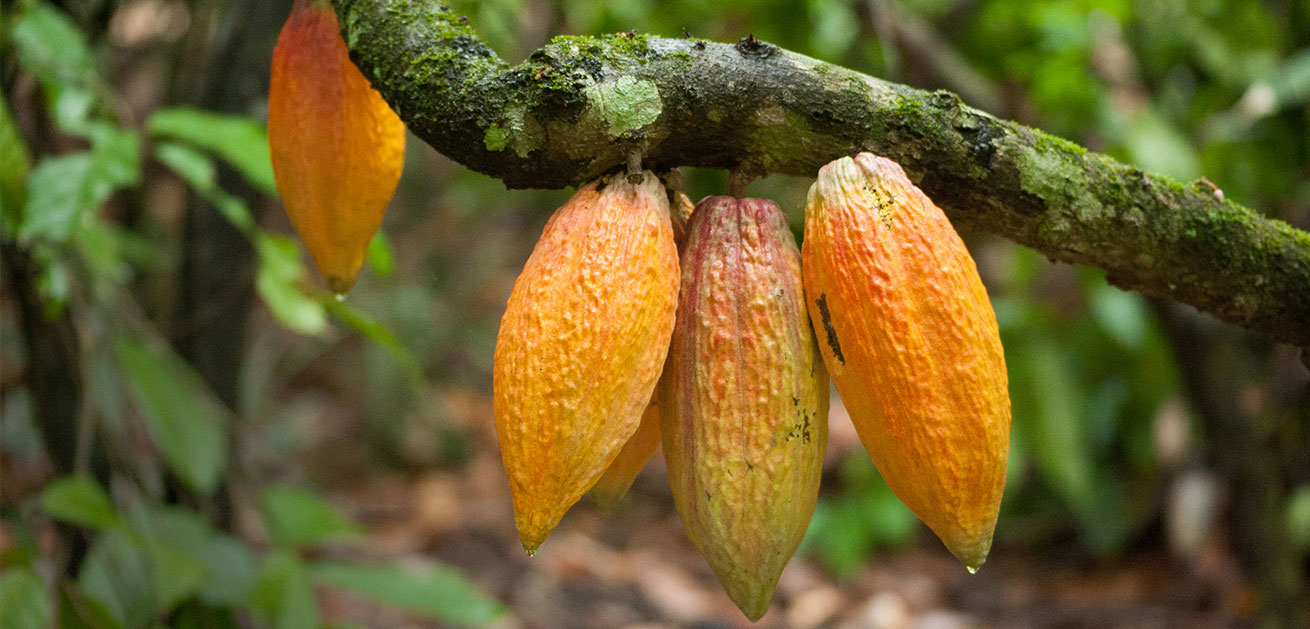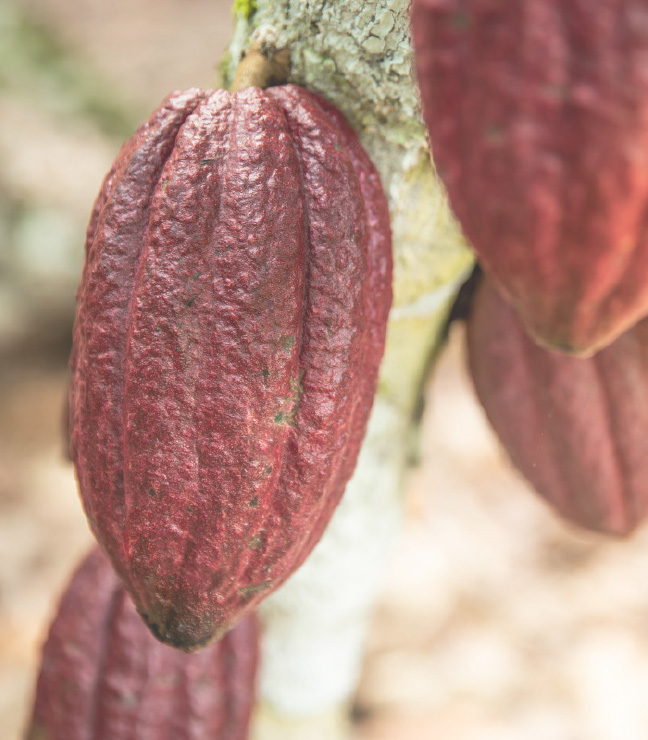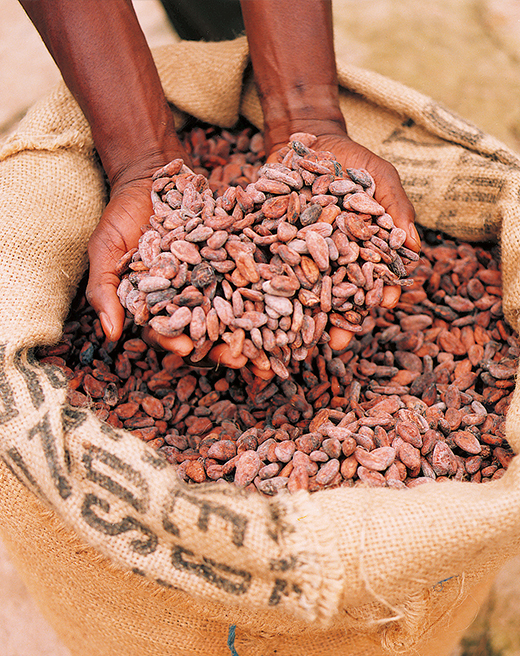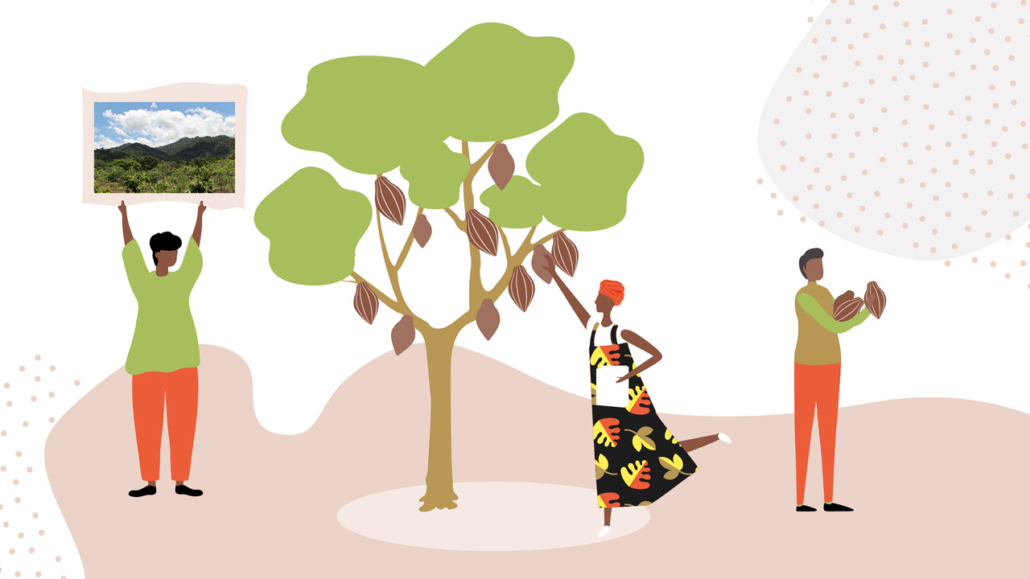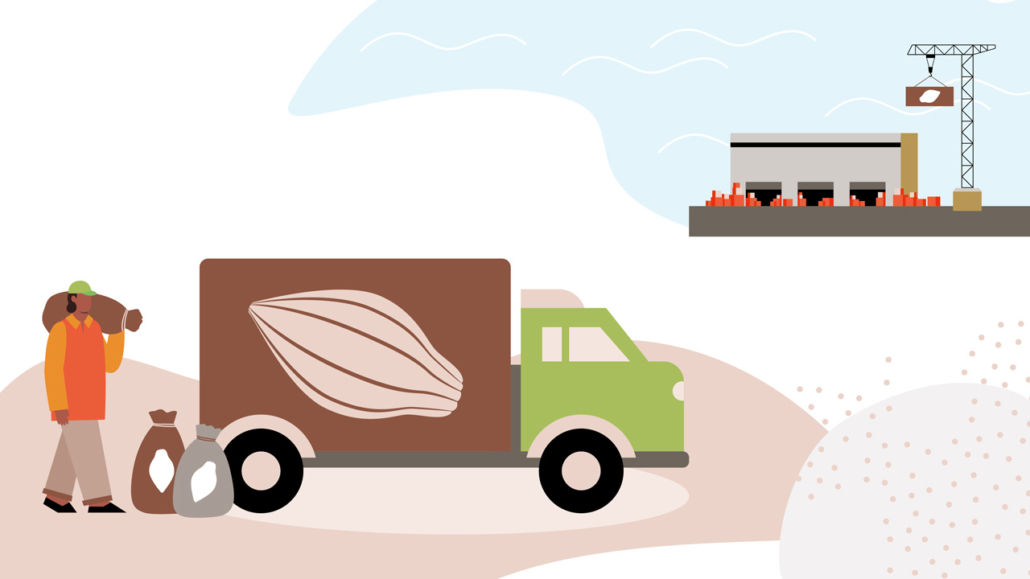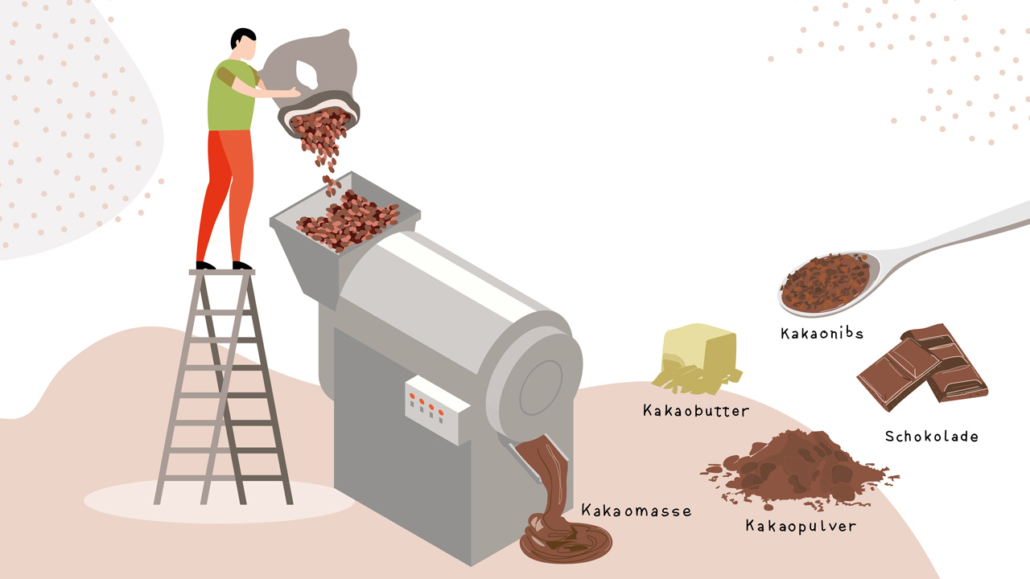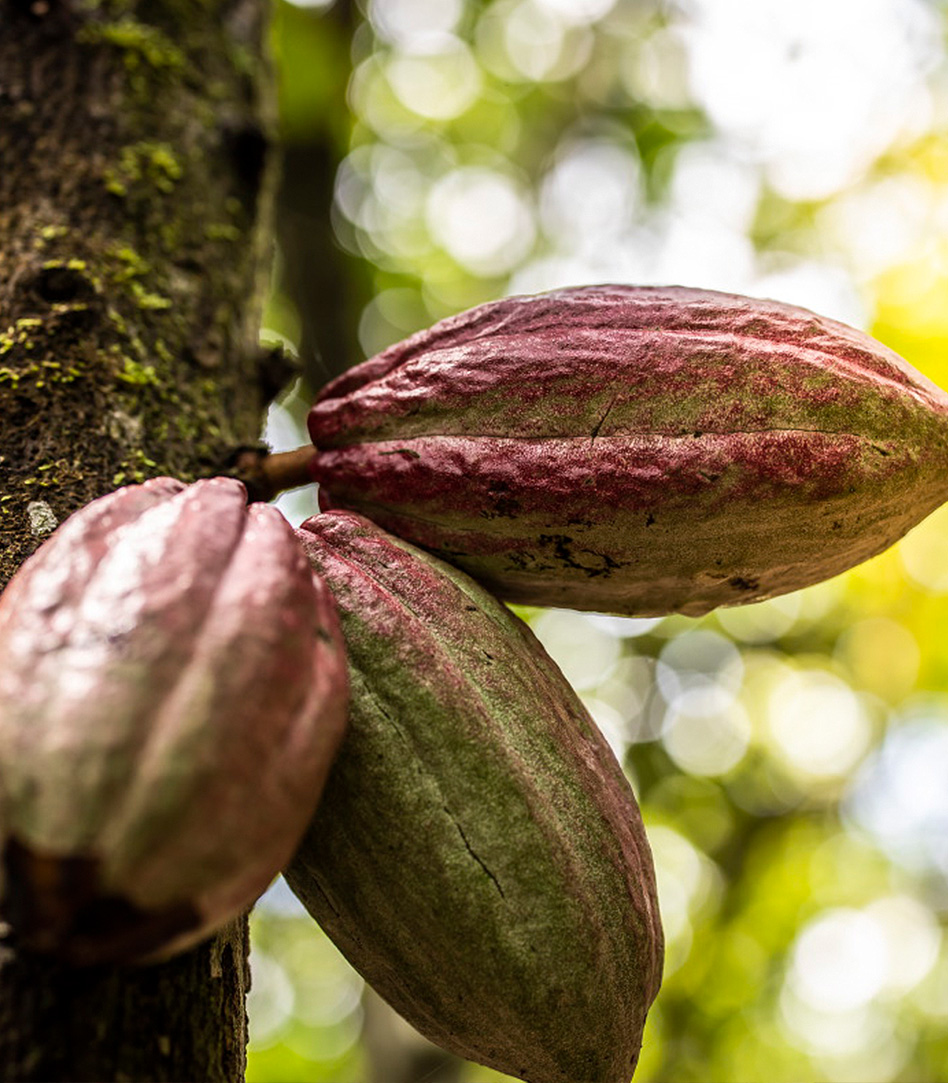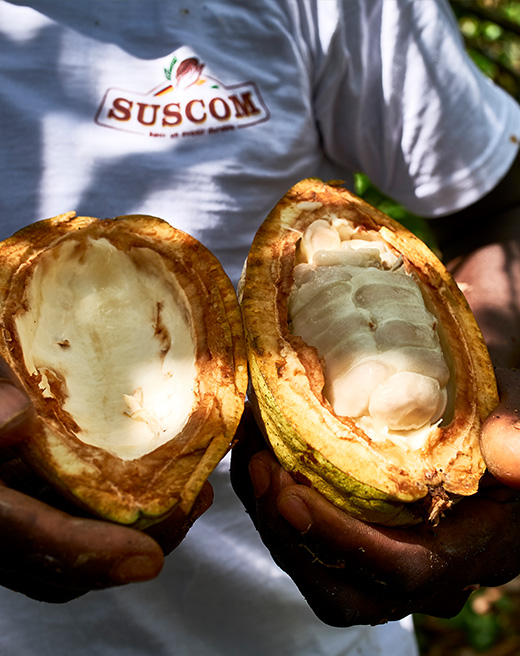The cocoa commitment sustainability program
Defining effective practices, supporting farmers, making cocoa traceable
In order to tackle the sustainability challenges in sourcing cocoa, we develop and implement effective measures tailor-made for the respective growing regions, as the situation varies considerably from one area to another. These measures improve the financial and social conditions on the farms and in the village communities while also protecting nature and the climate.
What does cocoa commitment stand for?
The KRÜGER GROUP is the initiator of the cocoa commitment sustainability program, which is open to all brands. With this program, we are dedicated to developing and implementing effective solutions to the challenges of sustainability in cocoa farming. Growers receive training in how to achieve good harvests in an environmentally friendly manner. The program builds on established certifications, like those from the Rainforest Alliance and Fairtrade, supplementing them with further measures and the promotion of Good Agricultural Practice (GAP), with training programs in sustainable agroforestry, the reforesting of croplands, and the protection of primeval forests. Purchasing cocoa commitment products sustainably supports farmers in the countries of origin.
A core element is the traceability of the raw cocoa and the raw cocoa volumes, from the farms to the KRÜGER GROUP’s own cocoa-processing factory in Germany, where cocoa powder, cocoa butter, and cocoa mass are made from the cocoa beans. The program is open to processing companies and trade partners so that as many farmers as possible may benefit from it.
We have made a good start, but there is still a long way to go. Products that bear the cocoa commitment seal are manufactured in part with cocoa grown from the cocoa commitment sustainability program. The cocoa from the program is certified by the Rainforest Alliance or Fairtrade, and additionally fulfills the sustainability measures of cocoa commitment. In this way, consumers can rest assured that their favorite branded products have been produced responsibly. By 2030, all cocoa-containing brand-name products of the KRÜGER GROUP will be required to obtain their cocoa through cocoa commitment.
The cocoa commitment program
Defining effective practices, supporting farmers, making cocoa traceable
In order to tackle the sustainability challenges in sourcing cocoa, we develop and implement effective measures tailor-made for the respective growing regions, as the situation varies considerably from one area to another. These measures improve the financial and social conditions on the farms and in the village communities while also protecting nature and the climate.
What does cocoa commitment stand for?
The KRÜGER GROUP is the initiator of the cocoa commitment sustainability program, which is open to all brands. With this program, we are dedicated to developing and implementing effective solutions to the challenges of sustainability in cocoa farming. Growers receive training in how to achieve good harvests in an environmentally friendly manner. The program builds on established certifications, like those from the Rainforest Alliance and Fairtrade, supplementing them with further measures and the promotion of Good Agricultural Practice (GAP), with training programs in sustainable agroforestry, the reforesting of croplands, and the protection of primeval forests. Purchasing cocoa commitment products sustainably supports farmers in the countries of origin.
A key element of this is the traceability of raw cocoa and raw cocoa volumes. The program is open to processing companies and trade partners so that as many farmers as possible may benefit from it.
We have made a good start, but there is still a long way to go. Products that bear the cocoa commitment seal are manufactured in part with cocoa grown from the cocoa commitment sustainability program. The cocoa from the program is certified by the Rainforest Alliance or Fairtrade, and additionally fulfills the sustainability measures of cocoa commitment. In this way, consumers can rest assured that their favorite branded products have been produced responsibly. By 2030, all cocoa-containing brand-name products of the KRÜGER GROUP will be required to obtain their cocoa through cocoa commitment.
The aims of
cocoa commitment
With cocoa commitment, we want to take a significant step toward marketing exclusively sustainably sourced cocoa in the future. We intend to achieve this goal through our active engagement in cocoa-growing countries. We seek to improve the income and living situations of families—especially of women—as well as prevent exploitative child labor practices and raise educational standards. To protect the environment, we strive to prevent the logging of rainforests, convert from conventional cultivation to climate-resilient agroforestry with high biodiversity, reforest fallow land, and reduce the use of chemical fertilizers and pesticides. We undertake all of these efforts so that local communities can prosper, now and in the future.
How the sustainability program works
How the sustainability program works
Defining effective practices
Actionable, effective, and verifiable criteria and measures have been specially developed for cocoa commitment, building on the Rainforest Alliance and Fairtrade certifications. These sustainability solutions are binding for all program participants and are to be adhered to on the cocoa farms and in the cocoa cooperatives—associations of small farms or growing operations. The typically small cocoa farms of, especially, West Africa, generally band together in such cooperatives to provide mutual support, share knowledge, and improve the marketing of their cocoa.
These measures include, among other things, the selection of locally appropriate varieties of cocoa trees; the commitment to convert to agroforestry, planting native trees as shade for the cocoa trees; the ban on using certain pesticides; and pest control preferably by means of natural methods. Because conditions in the various cocoa-growing countries differ markedly, the implementation plans that are developed include priorities which take regional specifics into account.
Supporting farmers
It is cocoa commitment’s goal that the cocoa farms and cooperatives comply with the defined criteria. We enable cocoa farmers to successively introduce sustainable methods of cultivation in their operations, and support them in their implementation.
We achieve this not through inspections and checklists, but through long-term partnerships on an equal footing with farmers. Continuous information exchange, knowledge-building, training, and projects and monitoring are central components of these partnerships. The corresponding measures include demonstrations of the correct pruning of cocoa trees, the replacement of old trees—rather than the creation of new plantations—and the optimal use of mulch, fertilizers, and pesticides. Occupational-safety measures are also included in the training sessions, as workplace injuries endanger farmers’ health and life, and in turn their harvests and the economic security of their families.
Monitoring success
Checklists are good, on-site checks are better. The farms, cooperatives, and local trading companies are therefore monitored by experts at regular intervals.
However, another important tool is data that the farms and cooperatives can collect themselves. In addition to the recording of crop data, this includes GPS data for mapping farms. The initial measuring of the site and the size of the farmland is done using polygon mapping. By comparison with satellite images, it can be determined whether this information is correct or if the farmers have illegally expanded their farming area over the years, for example by clearing land belonging to adjacent conservation areas. Another comparison is made on the basis of harvest volumes. If a farm’s crop yield is larger than statistically expected for the officially specified farming area, the reason for this is investigated.
In the event of proven violations, measures are taken to change this behavior over the long term.
An important additional benefit of these measures is that the people on-site learn how to use management and monitoring techniques, enabling them to see their own successes.
Ensuring traceability
A central element of the cocoa commitment sustainability program is the complete traceability of the raw cocoa and the raw cocoa volumes, from the farms to the KRÜGER GROUP’s own cocoa-processing factory in Germany, where cocoa powder, cocoa butter, and cocoa mass are made from the cocoa beans. The farmers record their amounts.
All farmers have their own farmer ID, which makes it possible to trace the onward journey of the cocoa from each farm. Each step along the trade and transport route is also centrally recorded digitally. Only once the processing of the cocoa beans begins do they lose their identity. As the quality and flavor of cocoa vary greatly, it is necessary to mix cocoa beans to produce consistent quality. Conventional cocoa and cocoa from the cocoa commitment sustainability program are kept apart for accounting purposes within the supply chain. Consumers can thereby be sure that the certified amount of cocoa in a piece of chocolate comes from farmers who receive a fair sum for their product and can thereby improve their living situation.
Cocoa origin
Only raw cocoa from partner farms and cooperatives is included in the cocoa commitment sustainability program. All partner farms and cooperatives are certified by either the Rainforest Alliance or Fairtrade, which means they are subject to additional regular audits. The local buyers from cocoa trading companies serving cocoa commitment also know the cooperatives on a personal level, allowing them to assess the situation on the farms directly.
Cocoa transport
After harvesting, the farmers and cooperatives deliver the cocoa beans to the village collection points. There, the certified cocoa is recorded separately.
These collection points are used by all cooperatives in the vicinity of the respective village. The cocoa beans are collected there and transported to the harbors, where their quality is checked before they are shipped off in containers. At each step in the journey, the transported amounts are checked to ensure that they in fact correspond with the harvested amounts of cocoa commitment cocoa beans. This rules out any sudden miraculous increase in the volume of the cocoa commitment cocoa.
Cocoa processing
The origin and quantity of cocoa commitment cocoa can be traced as far as the raw-cocoa warehouse. Here, the cocoa beans are processed, and large amounts of cocoa from various cooperatives are mixed together. This ends the traceability of the cocoa beans themselves, but the traceability of the cocoa amounts remains.
To ensure the consistently high quality of the cocoa, beans from various batches are mixed, in some cases including beans from farms that don’t participate in the cocoa commitment sustainability program. However, the allocation of the cocoa amounts remains unchanged. The actual cocoa commitment cocoa may also be used in noncertified products—but without mass balance, the cocoa commitment seal isn’t allowed to be used on their packaging. Thus, the cocoa commitment seal on the packaging serves as the guarantee that the project farms have benefited from participating in the program.
Was ist ein
Kakao-Siegel?
Ein Kakao-Siegel ist Teil eines Nachhaltigkeitsprogramms für Kakao. Mit einem Kakao-Siegel werden Produkte auf der Verpackung kenntlich gemacht, in denen in der Regel ausschließlich zertifizierter Kakao verwendet wird.
Nachhaltigkeitsprogramme werden von verschiedenen Organisationen oder von Unternehmen der Kakao-Branche aufgelegt. Sie unterscheiden sich in den Kriterien, beispielsweise durch Anforderungen, Monitoring- und Audit-Instrumente oder Vereinbarungen zu Abnahmepreisen. Kakao-Siegel sind eine Besonderheit, da sie nur für ein einzelnes landwirtschaftliches Erzeugnis gelten. Das liegt daran, dass die Nachhaltigkeits-Herausforderungen beim Kakao anders sind als bei beispielsweise Kaffee oder Palmöl. Nachhaltigkeitssiegel, die nicht nur für Kakao gelten, haben deshalb für jedes landwirtschaftliche Erzeugnis eigene Kriterien. Beispiele für solche Programme sind Rainforest Alliance oder Fairtrade. Zudem ist es möglich, Kakao-Siegel zu kombinieren, beispielsweise cocoa commitment mit Rainforest Alliance oder Fairtrade.
Welche Siegel garantieren einen nachhaltigen Kakaoanbau?
Bei jedem Siegel für Kakao unterscheiden sich sowohl die Kriterien als auch die Umsetzungsstrategien. Man kann jedoch sagen, dass jedes Siegel für nachhaltigen Kakao-Anbau besser ist als kein Siegel. Keine Garantie für nachhaltigen Anbau liefert das EU-Bio-Siegel. Deshalb wird Bio-Kakao oft, aber nicht immer, zusätzlich nach den Kriterien eines Nachhaltigkeits-Labels produziert.
Was ist ein Nachhaltigkeitslabel?
Ein Nachhaltigkeitslabel ist ein Teil von Zertifizierungsprogrammen für Lebensmittel und Konsumgüter. Im Gegensatz zu Bio-Siegeln kommen andere, eigene Kriterien zur Anwendung, bei denen neben der Natur auch der Mensch eine wichtige Rolle spielt. Erst wenn ein Produkt ein Nachhaltigkeitslabel trägt, kann man sicher sein, dass auch soziale Standards eingehalten werden. Ebenso achten Nachhaltigkeitslabel beispielsweise bei Lebensmitteln auf nachhaltigen Anbau, was oft auf den Schutz von Regenwäldern und von Biodiversität abzielt.
